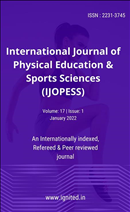The Role of Physical Education in the Development of Students Social and Psychological Personality Qualities
Main Article Content
Authors
Abstract
When engaging with the people in their environment, everyone reveals aspects of theirpersonality and character. How these characteristics form may be affected by a wide range ofenvironmental factors. Physical education is a crucial part of this procedure. The process of teacherfitness at a university is described as one area of educational activity that helps educators socially adaptto university conditions fosters the development of prospective professionals' socially andprofessionally substantial personal qualities their capacity for advancement in the continuouslyshifting circumstances of a social environment and interpersonal production. The authors put a premiumon the influence of a person's upbringing, peers, and one's own mind on their maturation and maturationinto their ideal selves.
Downloads
Download data is not yet available.
Article Details
Section
Articles
References
- Alkhateeb SA, Alkhameesi NF, Lamfon GN et al. Pattern of physical exercise practice among university students in the Kingdom of Saudi Arabia (before beginning and during college): a cross-sectional study. BMC Public Health 2019;19:1716. https://doi.org/10.1186/s12889- 019-8093-2
- Allender S, Cowburn G, Foster C. Understanding participation in sport and physical activity among children and adults: a review of qualitative studies. Health Education Research 2016;21(6):826-835. https://doi.org/10.1093/her/cyl063
- Alpatanni P. Personality 2015. https://www.research gate.net/publication/287217339_Personality
- Artino AR Jr. Academic self-efficacy: from educational theory to instructional practice. Perspectives on medical education 2018;1(2):76-8
- Barrick MR, Mount MK, Strauss JP. Conscientiousness and Performance of Sales Representatives: Test of the Mediating Effects of Goal Setting. Journal of Applied Psychology 2020;78(5):715-722.
- Bassett DR, Fitzhugh EC, Heath GW, Erwin PC, Frederick GM, Wolff DL et al. Estimated energy expenditures for school-based policies and active living. American Journal of Preventive Medicine 2016;44(2):108-113.
- Bassi M et al. Academic Self-Efficacy Beliefs and Quality of Experience in Learning. Journal of Youth and Adolescent 2017;36:3. PubMed. http://iasir.net/AIJRHAS Spapers/AIJRHASS18-242.pdf
- Bevans K, Fitzpatrick LA, Sanchez B, Forrest CB. Individual and Instructional Determinants of Student Engagement in Physical Education. Journal of teaching in physical education: JTPE 2017;29(4):399-416. https://doi.org/10.1123/jtpe.29.4.399
- Bichescu A. Leisure Time Sport Activities of the Students at Resita University. Procedia - Social and Behavioral Sciences 2015;117:735-740. https://www.sci encedirect.com/science/article/pii/S1877042814018217
- Biddle S, Asare M. Physical activity and mental health in children and adolescents: a review of reviews. British Journal of Sports Medicine 2021. doi:10.1136/bjsports2011-09018.
- McCrae, R. R., & Costa, P. T. (2018). A five-factor theory of perspective, Personality in Adulthood (2nd ed.). New York, London: The Guilford Press.
- Mansour, M., & Dadsetan, P. (2019). Genetic Psychology (2nd Volume). Tehran: Javaneh Roshd.
- Ployhart, R., Lim, B., & Chan, K. (2021). Exploring relations between typical and maximum performance and the five-factor model of personality. Personnel Psychology, 54, 809-843

